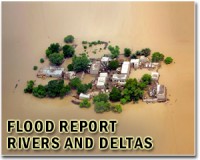| . |  |
. |
Seattle WA (SPX) Jan 31, 2011 Last summer's disastrous Pakistan floods that killed more than 2,000 people and left more than 20 million injured or homeless were caused by a rogue weather system that wandered hundreds of miles farther west than is normal for such systems, new research shows. Storm systems that bring widespread, long-lasting rain over eastern India and Bangladesh form over the Bay of Bengal, at the east edge of India, said Robert Houze, a University of Washington atmospheric sciences professor. But Pakistan, on the Arabian Sea west of India, is substantially more arid and its storms typically produce only locally heavy rainfall. The flooding began in July and at one point it was estimated that 20 percent of Pakistan's total land area was under water. Structural damage was estimated at more than $4 billion, and the World Health Organization estimated that as many as 10 million people had to drink unsafe water. Houze and colleagues examined radar data from the Tropical Rainfall Measuring Mission satellite and were able to see that the rainfall that caused the Indus River in Pakistan to overflow was triggered over the Himalayas, within a storm system that had formed over the Bay of Bengal in late July and moved unusually far to the west. Because the rain clouds were within the moisture-laden storm from the east, they were able to pour abnormal amounts of rain on the barren mountainsides, which then ran into the Indus. The progress of the storm system stood out in the satellite radar data, Houze said. "We looked through 10 years of data from the satellite and we just never saw anything like this," he said. "The satellite only passes over the area a couple of times a day, but it just happened to see these systems at a time when they were well developed." Houze is the lead author of a paper detailing the findings to be published in the Bulletin of the American Meteorological Society. Co-authors are Kristen Rasmussen, Socorro Medina and Stacy Brodzik of the UW and Ulrike Romatschke of the University of Vienna in Austria. Houze also will discuss the findings during a session Tuesday (Jan. 25) at the American Meteorological Society's annual meeting in Seattle The storms were associated with a wind pattern that could be traced in the satellite data back to its origin over the Bay of Bengal, Houze said. Finding the storm system's signature in the satellite data makes it possible to incorporate that information into weather forecast models. That could make it possible for meteorologists to forecast when conditions are favorable for such an event to occur again and provide a warning. "I think this was a rare event, but it is one you want to be thinking about," Houze said. "Understanding what happened could lead to better predictions of such disasters in the future."
Share This Article With Planet Earth
Related Links University of Washington Bringing Order To A World Of Disasters When the Earth Quakes A world of storm and tempest
 Raging Bolivia river sweeps away bus, killing 34
Raging Bolivia river sweeps away bus, killing 34La Paz (AFP) Jan 30, 2011 At least 34 people were killed when a river in southeastern Bolivia burst its banks, sweeping away a passenger bus and a truck, authorities said Sunday. Bodies have been washing up on the banks of the Mollepunku River since the incident late Friday near the town of Pampahuasi, 700 kilometers (435 miles) southeast of the Andean nation's capital La Paz, police said. The passenger bus had b ... read more |
|
| The content herein, unless otherwise known to be public domain, are Copyright 1995-2010 - SpaceDaily. AFP and UPI Wire Stories are copyright Agence France-Presse and United Press International. ESA Portal Reports are copyright European Space Agency. All NASA sourced material is public domain. Additional copyrights may apply in whole or part to other bona fide parties. Advertising does not imply endorsement,agreement or approval of any opinions, statements or information provided by SpaceDaily on any Web page published or hosted by SpaceDaily. Privacy Statement |